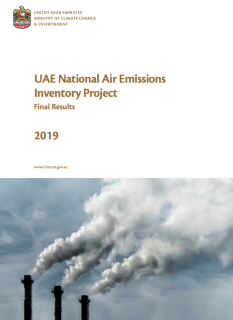
Improving air quality is a priority for the United Arab Emirates (UAE). It is part of the country’s Green Agenda and one of the key performance indicators in the National Agenda of the UAE Vision 2021. In July 2017, the Ministry of Climate Change and Environment (MOCCAE) launched the Air Emissions Inventory Project to develop the first national-level inventory for air pollutant emissions in the UAE. The objective of the project was to identify the key sources of air pollutants in the country with the view of formulating strategies that can be put in place to improve air quality. The Air Emissions Inventory Project was carried out in two phases. Phase I involved the development of the inventory methodology, which was successfully completed in 2018, and training for stakeholders on data collection. Phase II comprised the data collection and compilation of the national air pollutants inventory.
This report presents the results from Phase II of the Air Emissions Inventory Project. It is the first national air pollutant emission inventory carried out for the whole country. Using 2015 as the base year, the inventory undertaken included the following pollutants: carbon monoxide (CO), nitrogen oxides (NOx), sulphur dioxide (SO2), particulate matter of 10 micrometres or less (PM10), particulate matter of 2.5 micrometres or less (PM2.5), and non-methane volatile organic compounds (NMVOCs). Emissions are classified into the energy, transport, industrial processes and product use (IPPU), agriculture, and waste sectors.
The emissions inventory shows that emissions from the stationary energy and transport sectors dominate the emission sources. Power generation and road transport comprise a large proportion of the NOX emissions, with oil and gas operations also contributing a significant amount. For SO2 emissions, oil and gas operations are the dominant source, while petrol-fuelled passenger cars and light duty vehicles comprise the majority of CO emissions, with the IPPU sector also being an important source. For particulate matter (both PM10 and PM2.5), the dominant source is IPPU, with smaller amounts arising from fuel combustion in industry and transport, from brake and tyre wear. Although the agriculture and waste sectors have a minor contribution to the country’s overall emissions, their role is more significant in terms of greenhouse gas (GHG) emissions. However, of particular note are the estimated high NMVOC emissions from municipal solid waste (MSW) disposal on land.
